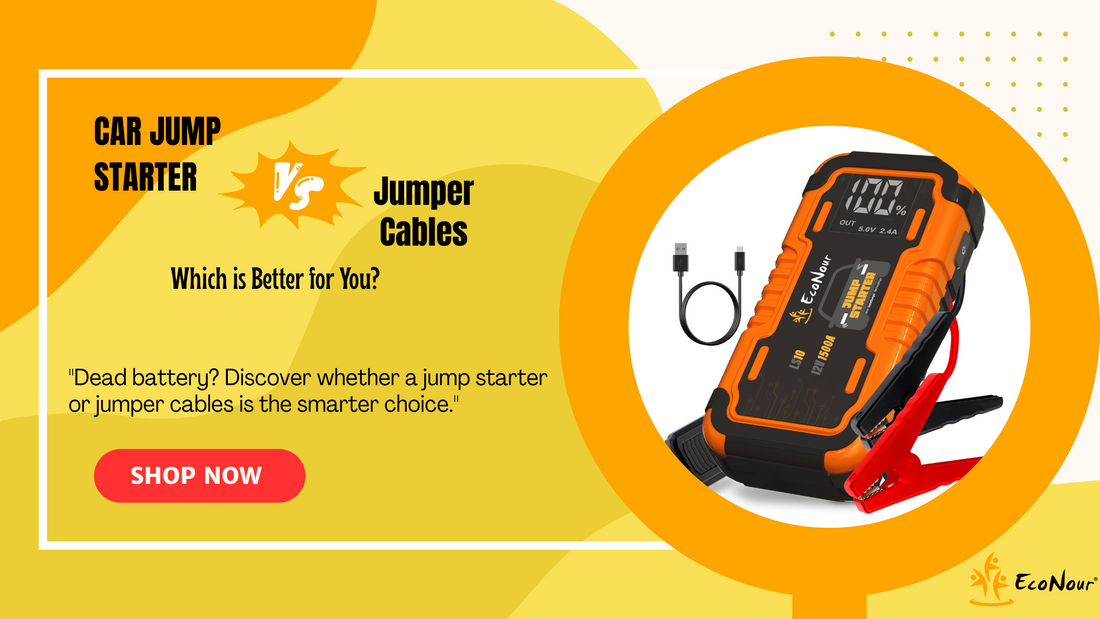
Car Jump Starter vs. Jumper Cables: Which is Better for You?
Share
When your car battery dies, it can leave you stranded at the most inconvenient times — in freezing winters, late nights, or on remote roads. Traditionally, drivers have relied on jumper cables to revive a dead battery, but modern technology has introduced a more reliable solution: the car jump starter. If you’ve ever wondered which option is better for your safety, convenience, and budget, this guide will help you decide.
What Are Jumper Cables?
Jumper cables are a set of heavy-duty insulated wires with clamps at both ends. They work by connecting your dead battery to another vehicle’s working battery, allowing power to flow and restart your engine. While jumper cables are affordable and widely available, they come with major limitations: you always need another vehicle nearby, proper knowledge of connection, and the patience to deal with cables in freezing or stressful conditions.
What Is a Car Jump Starter?
A car jump starter is a portable battery-powered device designed to start your car without needing another vehicle. Unlike jumper cables, these compact devices are independent power sources that can quickly recharge your dead battery. Many modern jump starters also come with extra features like built-in LED flashlights, SOS lights, USB charging ports, and even air compressors, making them an all-in-one emergency tool.
Key Differences: Jump Starter vs. Jumper Cables
While both tools serve the same purpose — starting your car — they differ in how they work and the convenience they provide:
- Dependence: Jumper cables require another car; jump starters work independently.
-
Ease of Use: Jumper cables can be tricky and risky if connected wrong; jump starters are beginner-friendly.
-
Safety: Jump starters come with built-in protections (spark-proof, overload, reverse polarity).
- Portability: Both are portable, but jump starters are compact, safer, and multifunctional.
- Winter Emergencies: Jumper cables may fail if no one is around; jump starters are a lifesaver in isolated conditions.
In short, jumper cables are the traditional solution, while jump starters are the modern, reliable upgrade.
Benefits of Using a Car Jump Starter
Investing in a jump starter for your car comes with several advantages over old-school jumper cables:
-
No need for another car – Start your vehicle anytime, anywhere.
-
Safe for beginners – Built-in safety features prevent sparks and wrong connections.
-
Works in emergencies – Perfect for remote areas, late-night breakdowns, and winter mornings.
-
Multi-functional – Many models double as power banks to charge phones, tablets, and laptops.
-
Compact & portable – Store it in your glove box or trunk for peace of mind.
-
Extra features – LED flashlight, SOS mode, and even built-in air compressors in some models.
Different Types of Car Jump Starters at EcoNour
EcoNour offers a range of car jump starters designed to suit different needs and vehicle types:
- Compact Mini Jump Starters – Perfect for small cars and easy to carry in your glove box.
- Heavy-Duty Jump Starters – Designed for SUVs, trucks, and larger batteries that need extra power.
-
Multi-Function Jump Starters – Equipped with USB ports, flashlights, and SOS signals — ideal for emergency preparedness.
- Jump Starter + Air Compressor Combo – A must-have for long road trips, giving you the power to jump-start your car and inflate tires.
You can explore EcoNour’s full collection here: EcoNour Car Jump Starters.
Conclusion
While jumper cables are still a budget-friendly option, they come with serious limitations that can leave you stranded when help isn’t available. On the other hand, a car jump starter provides independence, safety, and peace of mind, making it the smarter choice for modern drivers. With EcoNour’s reliable range of jump starters, you’ll always be prepared for unexpected dead batteries and winter emergencies.
Frequently Asked Questions (FAQ) About Car Jump Starters vs. Jumper Cables
1. How often should I charge my car jump starter?
Most car jump starters should be recharged every 2–3 months to ensure they’re ready when you need them. Always check the indicator lights before heading on a long trip.
2. Can I use a jump starter on trucks or SUVs?
Yes! Heavy-duty jump starters are designed for larger batteries in SUVs, trucks, and vans. EcoNour offers high-capacity models that are perfect for bigger vehicles.
3. Are jump starters safe for beginners?
Absolutely. Unlike jumper cables that require another car and careful handling, jump starters come with built-in safety protections such as spark-proof technology, reverse polarity protection, and overload protection.
4. Do jumper cables still work if no other car is around?
No. Jumper cables require another vehicle’s working battery, which makes them unreliable in remote areas or during emergencies when help isn’t available.
5. Can a jump starter damage my car’s battery?
No, as long as you use a quality jump starter like those from EcoNour, which have regulated power output and safety features. Using incorrect cables or poor-quality devices is where risks usually occur.
6. Can I use a car jump starter to charge phones and other devices?
Yes! Many modern jump starters double as power banks with USB and Type-C ports. They can charge smartphones, tablets, and even laptops.
7. What is the lifespan of a car jump starter?
On average, a good jump starter lasts 3–5 years with proper care and regular recharging. EcoNour’s durable jump starters are built for long-term reliability.
8. Which is better in winter — jumper cables or a jump starter?
A jump starter is much better for winter. Jumper cables can be inconvenient and require another car, while jump starters can power up your battery instantly even on freezing mornings.
